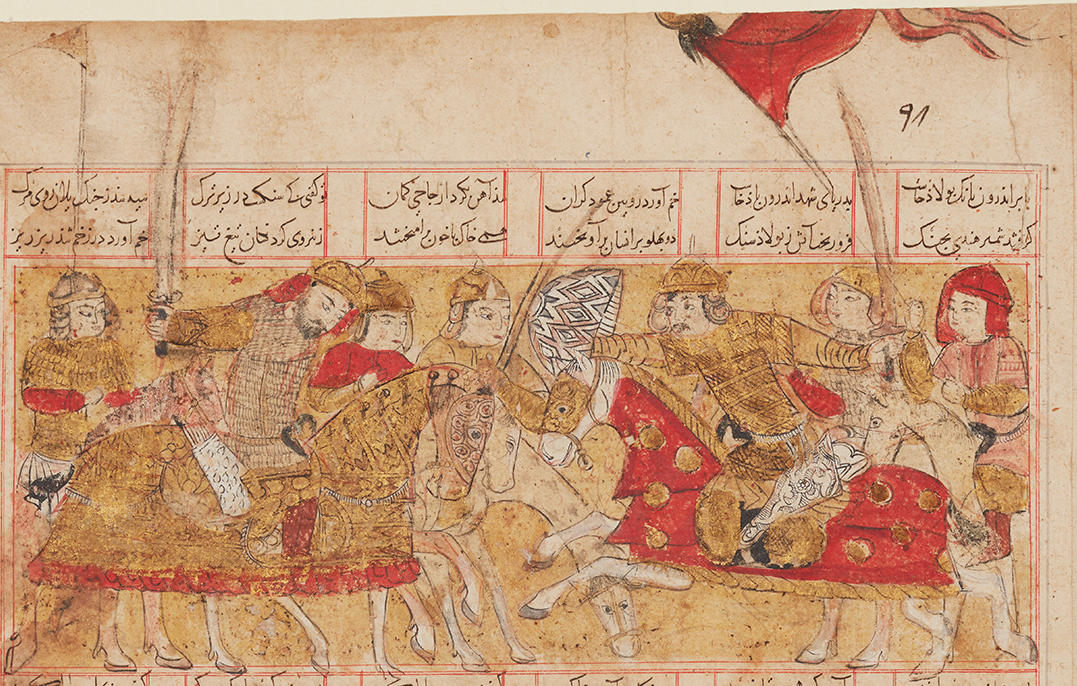
Try Amazon Audible Plus
Ilkhanid Illustration
Human fights Tus
from the 1341 Inju Shahnama, Shiraz



TUS BATTLES HUMAN
FOLIO FROM A DISPERSED COPY OF FIRDAUSI’S SHAHNAMEH (BOOK OF KINGS)
Accession Number: AKM32
Place: Iran, Shiraz
Dimensions: 35.6 x 29.9 cm
Date: 741 AH / 1341
Materials and Technique: Ink, coloured pigments and gold on paper
Like so many tales in Firdausi’s epic poem the Shahnameh (Book of Kings), completed in 1010, the narrative depicted here plays out against the backdrop of the war between Iran and Turan (Central Asia). This war was initiated by Kay Khusrau’s desire to avenge the death of his father Siyavush. Son of the legendary and often foolish King of Iran, Kay Kavus, Siyavush had taken refuge at the court of the Turanian ruler Afrasiyab after quarrelling with his own father. He married Afrasiyab’s daughter, but was executed when his father-in-law later turned against him. After returning to Iran with his mother, the young Kay Khusrau was recognized as the legitimate heir to the Iranian throne. HIs reign would be dominated by military expeditions to Turan and bloody encounters between the Iranian and Turanian warriors and heroes.
Further Reading
In this folio AKM32 (folio 98 recto), Tus, an Iranian commander, engages Human, a Turanian warrior, in battle that does not end in death, but rather a stalemate. The warriors’ day-long conflict involves all manner of weapons—maces, Indian scimitars, bows and arrows. At the end of the day, however, both retire from the field, vowing to fight again another time. In such a crowded composition—which includes mounted troops, two flag bearers, and several horses in addition to the two principal protagonists—Tus and Human cannot be easily identified. Firdausi’s narrative does mention a shield that Human uses to protect his head, lending credence to the possibility that Human is the beardless warrior on the right extending a domed-shaped shield decorated with a sunburst and diamond pattern. Such a distinctive pattern may have been inspired by verse in which Firdausi characterizes the atmosphere of this long fight as day turned to night: “The mid-day sun, the world became as 'twere / Night's second watch, its face like diamonds.”
Great attention is given in this illustration to the protective coverings worn by the horses. The horse with its neck stretched to the ground is almost comical, though its lighter colour creates an interesting effect of depth, providing contrast for the warriors’ two steeds in the foreground. The underdrawing—notable in the red strokes on the rider and horse in the left side of the painting—reveals the process whereby the manuscript’s artist (or artists) would outline figures before applying pigment. These lines are visible throughout the illustrations of the 1341 Shahnameh.
— Marianna Shreve Simpson
Source: Aga Khan Museum AKM32
Geneva, Aga Khan Trust for Culture
Title of Work: Shahnama (1341)
Manuscript: 2005.1.28-37 (Ir.M. 6-6/I)
Accession Number: 2005.1.32 (Ir.M. 6/D)
Chapter 13b - Kamus-i Kashani
Scene: Human fights Tus
Dimensions (h x w): 92 x 234 mm
Format: Rectangular within borders
Reconstructed Folio: 98r
Hijri Date: 741 Dhu'l-Qa'da 20
Gregorian Date: 1341 May 14
School: Shiraz
Source: Shahnama Project